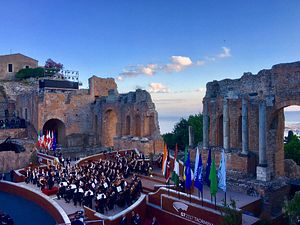Following two days of meetings in Taormina, Italy, on May 26 and 27, the heads of state and government from the Group of Seven (G-7) countries — Canadian Prime Minister Justin Trudeau, French President Emmanuel Macron, German Chancellor Angela Merkel, Italian Prime Minister Paolo Gentiloni, Japanese Prime Minister Shinzo Abe, and U.S. President Donald J. Trump — issued a joint communiqué (PDF) that addressed a range of international issues.
This year’s communiqué, like last year’s, drew attention to ongoing maritime tensions in the Asia-Pacific, focusing specifically on the East and South China Seas. The G-7 leaders expressed their “commitment to maintaining a rules-based order in the maritime domain based on the principles of international law.” The communiqué additionally expressed support for the United Nations Convention on the Law of the Sea (UNCLOS) and for the peaceful settlement of maritime disputes “through diplomatic and legal means, including arbitration.” The communiqué does not mention the July 2016 award by a Hague-based tribunal in the Philippines’ case against China over the South China Sea.
The communiqué continued that the leaders were concerned “about the situation in the East and South China Seas” and “strongly opposed to any unilateral actions that could increase tensions.” The statement came days after the United States carried out its first freedom of navigation operation (FONOP) in the South China Sea since Trump’s inauguration, drawing a sharp reaction from China, which included an aerial intercept of a U.S. surveillance aircraft in international airspace near Hainan Island.
Finally, in a departure from a statement on maritime security released at last year’s G-7 leaders’ meeting in Ise-Shima, Japan, the leaders this year noted in the communiqué that “all parties” in the region should “pursue demilitarization of disputed features” — a tacit acknowledgement that militarization of the South China Sea was a fait accompli. While China’s construction of seven artificial islands in the Spratly group has drawn considerable attention since 2014, other claimants, including Vietnam, the Philippines, and Taiwan, also have a military presence on disputed features.
The communiqué does, in this sense, go farther than the G-7 Hiroshima ministerial statement on maritime security in 2016, which called on parties to “refrain from such actions as land reclamations including large scale ones, building of outposts, as well as their use for military purposes,” and acknowledges that China’s construction of artificial islands and their subsequent conversion into dual-use facilities is effectively complete. The 2015 G-7 leaders’ statement only mentioned out land reclamation in the South China Sea, without making reference to military activities.
Unsurprisingly, China has already made its dissatisfaction with the G-7’s communiqué clear. Beijing is “strongly dissatisfied” with the statement, per Chinese Foreign Ministry spokesperson Lu Kang. Lu reiterated China’s position on the disputes in the East and South China Seas, noting that Beijing seeks to solve disputes through negotiations while maintaining peace.
































